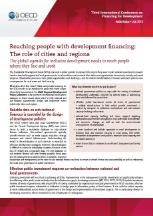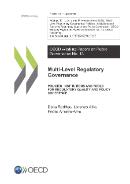Regional, rural and urban development
Multi-level Governance and Public Finance
|
The issues | At the OECD | Principles | Sub-national finance |Territorial Reviews | Water | Regulatory
|
Relations across levels of government have changed over the last two decades. Decentralisation has made local and regional governments more powerful in formulating and delivering policy thereby increasing their scope for improving the competitiveness of the regional economy and the well-being of residents.
This change from a centralised and "vertical" system has made governance more complex by involving a wider range of stakeholders at different levels. As a result both horizontal and vertical relationships are increasingly important. Understanding this complex network of relationships, as well as developing effective collaboration between levels of government, is critical to enable efficient policy making and service delivery.
Multilevel governance at the OECD
|
OECD work on multi level governance addresses both vertical and horizontal dimensions. A multi-level governance framework has been formulated by the OECD and has been used in several areas of work related to multi-level governance including on Public investment, regional development, urban development, local finances, water governance, regulatory policy or environmental issues such as climate change. |
|
At the Third International Conference on Financing for Development held in Addis Ababa, Ethiopia on 13-16 July 2015, high-level policy makers from across the globe gathered to agree on a new framework to finance the ambitious post-2015 development agenda. The multi-level approach concerns OECD regions as well as developing countries and regions. Read Reaching people with development financing: The role of cities and regions (PDF). |
 |
OECD principles on effective public investment
To promote good practices in the area of multi-level governance of public investment, the OECD has developed a recommendation on Effective public investment: a shared responsibility across levels of government, adopted by the OECD Council in March 2014 as an official OECD instrument.
Read more about the Recommention of the OECD Council on Effecitve Public Invesment Across Levels of Government.
The Effective Public Investment Toolkit is an on-line resource providing implementation guidance for the OECD Recommendation on Effective Public Investment Across Levels of Government. It supports both implementation and peer learning, with indicators and good practices from countries, regions, and municipalities.
Contact: dorothee.allain-dupre@oecd.org
|
Publication |
Investing Together: Working Effectively Across Levels of Government (2013) This report dissects the relationships different government actors form vertically, across levels of government, and also horizontally, across both sectors and jurisdictions. Sub-national actors also need to be equipped with the right skills and resources to carry out their responsibilities and to engage with stakeholders, across the public, private and civil society sectors. This report offers a toolkit to policy makers to assess their needs for capacity development.
Consult the full list of publications on Multi-level governance. |
|
Sub-national governments play a significant role in public expenditure and investment. Across the OECD there are around 141 000 general purpose regional and local governments. Sub-national Governments in OECD Countries: Key Data: This statistical brochure provides key data on subnational governments structure and finance in the 34 OECD member countries: number of subnational governments by level and municipal size, expenditure, including by economic function, investment, revenue, tax revenue, budget balance and debt. Access the On-line data.
|
 |
|
|
This study was jointly conducted by the OECD and UCLG, with the support of Agence Française de Developpement (AFD). It aims at providing reliable and comparable facts and data on the structure, responsibilities and finance of subnational governments around the world. It is a first contribution to the Global Observatory on Local Finances. The 101 countries of the sample account for 82% of the world’s population, or close to 6 billion people spread over seven main regional areas: Africa, Asia Pacific, Euro-Asia, Europe, Latin America, Middle East and West Asia and North America. They total around 88% of the world GDP: 37% of countries are high-income economies on the basis of the World Bank classification, including a majority of OECD countries; 26% and 24% belong to respectively upper and lower-middle income groups while 14% are low income economies, coming all from the African continent. Access the online data
Contact: Isabelle.chatry@oecd.org |
 |
Multi-level governance in OECD Territorial Reviews
The OECD publishes territorial reviews at the national, regional and metropolitan levels which all contain a specific chapter on multi-level governance.
- Consult the complete list of national, regional and metropolitan reviews
Multi-level governance of water
|
Water governance is one policy area in which effective multi-level governance is vital. Managing water is a complex issue involving multiple stakeholders from all levels of government with different views and objectives. A lack of effective management of interdependencies and coordination across these stakeholders can hamper the efficient design and implementation of water policy reform. The publication Water Governance in OECD Countries: A multi-level approach identifies common governance gaps and is a tool for policy makers to carry out self-assessments and find commonalities with other regions. Contact: Aziza.akhmouch@oecd.org |
Water Governance in OECD Countries: A multi-level approach (2011) |
Multi-level regulatory governance
|
High-quality regulation at a certain level of government can be compromised by poor regulatory policies and practices at other levels. This negatively affects business and citizens, and thereby the economy as a whole. Following certain principles and good practices for high quality regulation in a coherent way, as well as facilitating co-ordination among regulatory institutions at different levels of government can bring improvements to the regulatory system as a whole.
|
Related Documents


